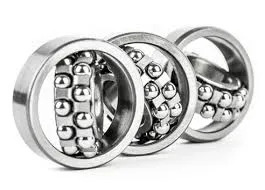
Oct . 11, 2024 07:32 Back to list
types of thrust bearings
Understanding the Types of Thrust Bearings
Thrust bearings are critical components in machinery where axial loads are present. These bearings can withstand forces directed along the shaft's axis and play a pivotal role in ensuring smooth operation in various mechanical systems. There are several distinct types of thrust bearings, each designed for specific applications and load conditions. This article explores the various types of thrust bearings, their construction, advantages, and typical applications.
1. Plain Thrust Bearings
Plain thrust bearings, also known as sliding thrust bearings, consist of two surfaces that slide against each other. These bearings utilize a lubricant to minimize friction and wear. They are often made from materials like bronze or polymer and are widely used in low-speed, low-load applications. An advantage of plain thrust bearings is their ability to handle shock loads efficiently, making them suitable for agricultural and automotive applications.
2. Roller Thrust Bearings
Roller thrust bearings are designed to handle higher axial loads than plain thrust bearings. They use rollers instead of sliding surfaces, which distribute the load over a larger area. This design significantly reduces friction and wear. Common types of roller thrust bearings include cylindrical roller and needle roller bearings. Due to their robustness, roller thrust bearings are frequently used in heavy machinery, marine applications, and automotive gear systems, where reliability under high load conditions is crucial.
Ball thrust bearings feature balls positioned between two raceways. This design allows for smooth rotation and can accommodate thrust loads in one direction. Although they are not as capable of handling heavy loads as roller thrust bearings, they offer smoother operation. Ball thrust bearings are commonly used in applications such as machine tools, automotive clutches, and tilt tables. They are favored for their ability to operate at higher speeds and their lower maintenance requirements.
types of thrust bearings

4. Tapered Roller Thrust Bearings
Tapered roller thrust bearings incorporate rolling elements that are shaped like a cone, allowing for the accommodation of both axial and radial forces. This unique design provides excellent load distribution and the ability to handle significant loads in either direction. Tapered roller thrust bearings are prevalent in heavy-duty applications, such as truck wheel hubs, where they must support both axial and radial forces. Their adaptability makes them an ideal choice for applications that involve varying load conditions.
5. Self-Aligning Thrust Bearings
Self-aligning thrust bearings are designed to accommodate misalignment between the shaft and housing. This capability is particularly valuable in applications where precise alignment cannot be guaranteed. Typically constructed with spherical roller elements, these bearings can handle some degree of angular misalignment while still providing effective load support. Self-aligning thrust bearings are often used in industrial gearboxes and conveyor systems, where alignment issues can arise due to vibration or thermal expansion.
6. Magnetic Thrust Bearings
An emerging technology in the field of thrust bearings is magnetic thrust bearings, which use magnetic forces to hold the rotor separate from the stator, eliminating mechanical contact and friction. This design results in minimal wear and tear and allows for high speeds and low maintenance. Magnetic thrust bearings are often found in high-precision applications such as aerospace engines and advanced robotics, where traditional bearings may not perform adequately.
Conclusion
Thrust bearings are indispensable in countless mechanical systems, providing support against axial loads and ensuring smooth operation. Understanding the various types of thrust bearings—plain, roller, ball, tapered roller, self-aligning, and magnetic—can aid engineers and designers in selecting the right bearing for their specific application. By choosing the appropriate type of thrust bearing, one can enhance machinery efficiency, prolong the lifespan of components, and ultimately contribute to the success of engineering projects.
Latest news
-
Spherical Roller Bearings Applications: Heavy Duty, Self-Aligning
NewsAug.30,2025
-
Premium Deep Groove Ball Bearings | High Speed & Reliability
NewsAug.29,2025
-
Durable Scaffolding Clamps - Secure & Reliable Tube Connectors
NewsAug.28,2025
-
Common Failures in Thrust Ball Bearings and Solutions
NewsAug.22,2025
-
How Tapered Roller Bearings Can Take Shock Loads
NewsAug.22,2025
-
Angular Bearings in High-Precision Spindles
NewsAug.22,2025
